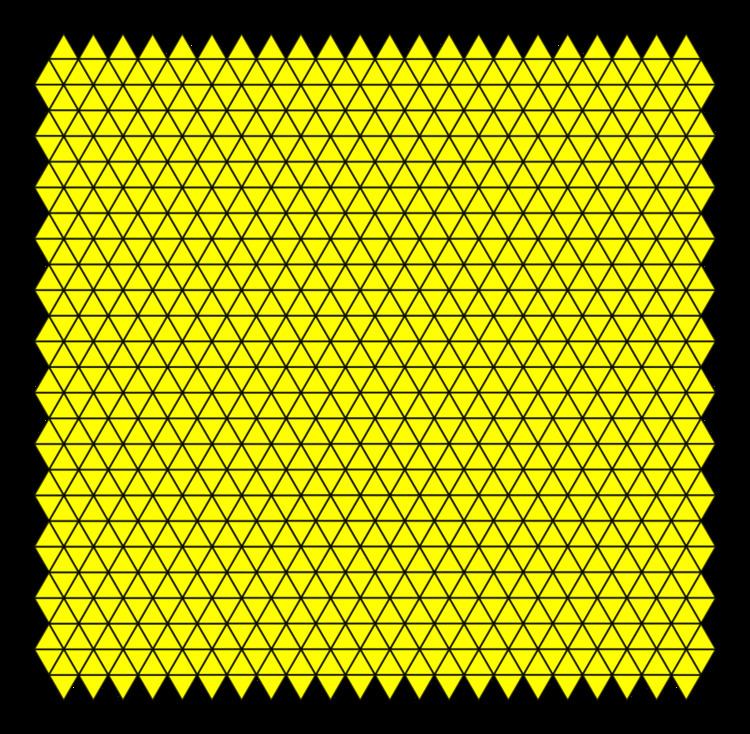 | ||
In geometry, the triangular tiling or triangular tessellation is one of the three regular tilings of the Euclidean plane. Because the internal angle of the equilateral triangle is 60 degrees, six triangles at a point occupy a full 360 degrees. The triangular tiling has Schläfli symbol of {3,6}.
Contents
- Uniform colorings
- A2 lattice and circle packings
- Geometric variations
- Related polyhedra and tilings
- Wythoff constructions from hexagonal and triangular tilings
- Related regular complex apeirogons
- Other triangular tilings
- References
Conway calls it a deltille, named from the triangular shape of the Greek letter delta (Δ). The triangular tiling can also be called a kishextille by a kis operation that adds a center point and triangles to replace the faces of a hextille.
It is one of three regular tilings of the plane. The other two are the square tiling and the hexagonal tiling.
Uniform colorings
There are 9 distinct uniform colorings of a triangular tiling. (Naming the colors by indices on the 6 triangles around a vertex: 111111, 111112, 111212, 111213, 111222, 112122, 121212, 121213, 121314) Three of them can be derived from others by repeating colors: 111212 and 111112 from 121213 by combining 1 and 3, while 111213 is reduced from 121314.
There is one class of Archimedean colorings, 111112, (marked with a *) which is not 1-uniform, containing alternate rows of triangles where every third is colored. The example shown is 2-uniform, but there are infinitely many such Archimedean colorings that can be created by arbitrary horizontal shifts of the rows.
A2 lattice and circle packings
The vertex arrangement of the triangular tiling is called an A2 lattice. It is the 2-dimensional case of a simplectic honeycomb.
The A*
2 lattice (also called A3
2) can be constructed by the union of all three A2 lattices, and equivalent to the A2 lattice.
The vertices of the triangular tiling are the centers of the densest possible circle packing. Every circle is in contact with 6 other circles in the packing (kissing number). The packing density is π⁄√12 or 90.69%. Since the union of 3 A2 lattices is also an A2 lattice, the circle packing can be given with 3 colors of circles.
The voronoi cell of a triangular tiling is a hexagon, and so the voronoi tessellation, the hexagonal tiling has a direct correspondence to the circle packings.
Geometric variations
Triangular tilings can be made with the equivalent {3,6} topology as the regular tiling (6 triangles around every vertex). With identical faces (face-transitivity) and vertex-transitivity, there are 5 variations. Symmetry given assumes all faces are the same color.
Related polyhedra and tilings
The planar tilings are related to polyhedra. Putting fewer triangles on a vertex leaves a gap and allows it to be folded into a pyramid. These can be expanded to Platonic solids: five, four and three triangles on a vertex define an icosahedron, octahedron, and tetrahedron respectively.
This tiling is topologically related as a part of sequence of regular polyhedra with Schläfli symbols {3,n}, continuing into the hyperbolic plane.
It is also topologically related as a part of sequence of Catalan solids with face configuration Vn.6.6, and also continuing into the hyperbolic plane.
Wythoff constructions from hexagonal and triangular tilings
Like the uniform polyhedra there are eight uniform tilings that can be based from the regular hexagonal tiling (or the dual triangular tiling).
Drawing the tiles colored as red on the original faces, yellow at the original vertices, and blue along the original edges, there are 8 forms, 7 which are topologically distinct. (The truncated triangular tiling is topologically identical to the hexagonal tiling.)
Related regular complex apeirogons
There are 4 regular complex apeirogons, sharing the vertices of the triangular tiling. Regular complex apeirogons have vertices and edges, where edges can contain 2 or more vertices. Regular apeirogons p{q}r are constrained by: 1/p + 2/q + 1/r = 1. Edges have p vertices, and vertex figures are r-gonal.
The first is made of 2-edges, and next two are triangular edges, and the last has overlapping hexagonal edges.
Other triangular tilings
There are also three Laves tilings made of single type of triangles:
